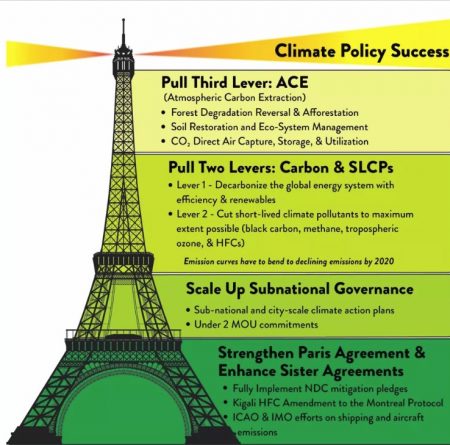September 2, 2018 – In the journal of Carbon Management, Japanese researchers from Kyoto University and the National Institute of Environmental Studies evaluate the role of socioeconomic factors in changing mitigation costs to limit global warming to 1.5 Celsius (2.4 Fahrenheit) rather than the 2 Celsius (3.6 Fahrenheit) number of the Paris Climate Agreement. Using a computer model the researchers input technological costs, energy demand, lifestyle changes, and social acceptance parameters and determined the following:
- technological improvements to low-carbon energy-supply was an important factor in reducing mitigation costs including carbon capture and sequestration (CCS) to create negative emissions, and biomass as an alternate energy source.
- energy efficiency improvements and lifestyle changes for the general public would have an even greater impact on mitigation costs in achieving the 1.5 Celsius target versus 2.0.
Socioeconomic factors include economic growth, population and other demographic factors (rural-to-urban migration for example), adoption of new technologies, and voluntary and government policy directed lifestyle changes.
The methodology for the study used the Asia-Pacific Integrated Model/Computed General Equilibrium, widely adopted by researchers for studying climate mitigation and impact assessment. The model covers 17 regions of the planet, and 42 business classifications detailing the energy, industrial, agricultural, forestry, and waste management sectors. Greenhouse gas (GHG) emissions including carbon dioxide (CO2), methane (CH4), nitrogen dioxide (N2O) and fluorinated gases contributed from all these sources were calculated.
In the model, the researchers applied a carbon tax beginning from 2011 as a mitigation strategy to attempt to reduce GHG emissions in all business classification areas. The model used to end targets in its analysis:
- a global mean temperature peak of 1.5 Celsius by 2040 before dropping to 1.3 Celsius by 2100.
- a global mean temperature peak of 2.0 Celsius by 2040 dropping to 1.7 Celsius by 2100.
Among the socioeconomic factors seen as mitigating carbon emissions were dietary changes to low-meat consumption, seen as important in achieving a lower mean temperature rise.
The use of biomass as an energy source alternative to fossil fuels was seen as a strong mitigating factor. And when combined with CCS it was seen as a method to achieve negative carbon emissions.
The study noted that negative emission initiatives would dramatically reduce mitigation costs and make the 1.5 Celsius target far more achievable. Among the strategies to accompany CCS, the study pointed to land-use changes such as reforestation and planting of bioenergy crops to yield negative emission results.
Energy efficiency and lifestyle changes to impact the demand side were seen as accelerators to achieve the lower mean temperature target of 1.5. In particular, lifestyle changes around transportation were seen as critical.
In its conclusions the study states:
“We found that progress in low-carbon energy-supply technologies is the strongest factor for reducing mitigation costs. Moreover, under the constraints of the 1.5 Celsius goal, the relative effectiveness of other socioeconomic factors, such as energy efficiency improvement, lifestyle changes and biomass-related technology promotion, becomes more important in decreasing mitigation cost in the 1.5 Celsius scenarios than in the 2 Celsius scenarios.”
So, in other words, tackling the energy production side of the equation is only part of the solution. Lifestyle changes make a 1.5 Celsius outcome far more likely, one that the Paris Climate Agreement referenced as a nice-to-have.
















